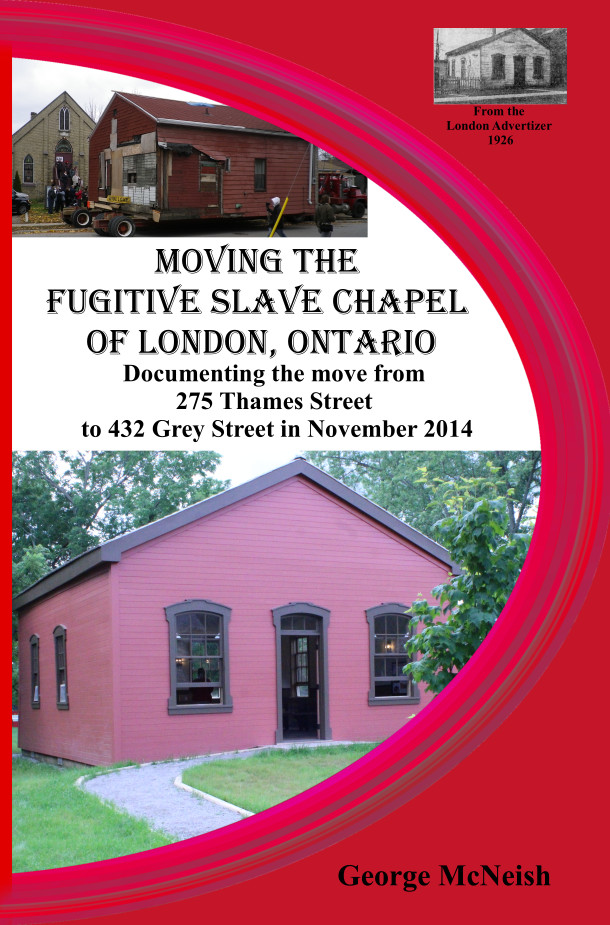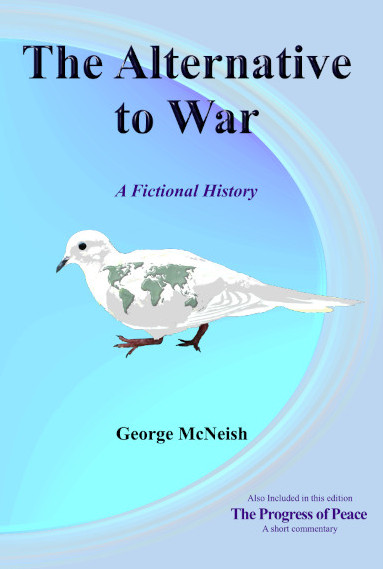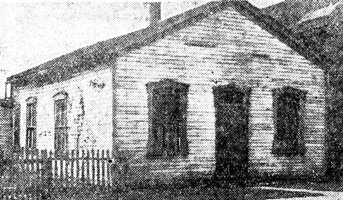 Kindle Version |
 Books By George McNeish. |
 Kindle Version |
 Books By George McNeish. |
 | A Book About the Fugitive Slave Chapelby George McNeish |
In "The Fugitive Slave Chapel of London Ontario" I delve into its History and the history of the Slaves that came. I look into the conditions of Slavery in the South to get a glimpse of what these Fugitives were escaping from. From the little known fact I attempt to imagine the state of mind of these citizens that arrived in the mid 1800's. The conditions they met and the obstacles they had to overcome are explored.
Abolitionist John Brown is rumoured to have spoken in the Church. I am about ninety percent sure this rumour is true. The 1926 reporter that claims to have spoken to two unnamed people who remembered the event seems to be adequate proof. The fact that the meeting needed to be kept secret explains why accounts of it are not widespread.
In this book I look into the life of John Brown. I examined accounts of his life as told by both his enemies and his friends. I read a speech given by a freed slave, Frederick Douglass, that started out uncomplimentary and turned into a glowing tribute to a white man who had greater influence on the abolition movement than any other single person.
While researching this book I looked into the conditions that resulted in the Civil War. I read about its devastating effect and the struggles with reconstruction afterwards. I started to wonder if this war was really necessary.
Thus I wrote a historical fiction (The Alternative) were the Civil War never happened.
"The Fugitive Slave Chapel of London Ontario" is a work in progress. with the sudden turn of events in October of 2018, I now feel it is time to complete it. Hopefully it will be published in 2019.
Below is I little piece I wrote about the Chapel a few years ago. It may or may not be included in the book. You can keep coming back to these pages as I will post interesting tidbits as I research and write the book.
Historic Value of 275 Thames Street, London, Ontario, CanadaThe Fugitive Slave Chapel of London, Ontario was built about 1848 presumably by fugitive slaves and perhaps other citizens of African descent. Little is known about how this building came into being but London land records show that trustees of the African Methodist Episcopal Church purchased the land at 275 Thames Street on October 14, 1847. One would speculate that the building would have been erected shortly after that date, but some sources put the date of construction as late as 1852. You may wonder at the lack of documentation for a building of such historical value, but, at the time, these few fugitives from our southern neighbour were insignificant and even unwanted, so their activities were largely ignored. Fleeing from slavery meant that they had endured hard labour with no wages paid, so it is not surprising that they had very little when they arrived in London. What they did have was an ability to work and a desire to succeed, so, despite odds against them, they worked, bargained and prospered. With only the finances that labour could bring them, they naturally congregated in an area of London were real estate was cheap. The smelly hollow at Thames Street was such a place during the middle of the nineteenth century. The coming of the railroad in 1853 soon changed all of that. Real estate values escalated and the black community of London were soon known to hold greater value in real estate than their white counterparts. When they arrived in Canada all these fugitives wanted was an equal opportunity to work and earn a living. Some well intentioned people took it on their selves to raise money for those they regarded as unable to succeed on their own. Others who were not so well intentioned used the situation of the fugitives to solicit money which seldom got to the intended destination. Either way this was not wanted by the black community. Many narratives of fugitive slaves who came to Canada stated that they felt handouts would make people lazy and they preferred to work for what they could earn. Equal opportunity is the most they asked for, and that they did not get. The prejudice in Canada was often worse than they faced in slavery, but in Canada they were free and had protection of the law. This was enough to enable them to work hard and prosper under adverse conditions. For more than 200 years the African American was told he was not human and could expect no human rights. He was brainwashed into thinking he had no capability to survive on his own and needed a master to look after his affairs. Many were so convinced of their inferior abilities that they made no attempt to escape slavery, but the ones who did manage to break the bonds of slavery proved that the common beliefs were utterly false. Not only did they succeed but they succeeded despite adverse conditions. They came together in small communities and helped each other to overcome obstacles. In slavery they had learned of the God of Christianity and many carried that belief with them when they came to Canada. White Christians would usually make them feel unwelcome, so they established their own churches. The African Methodist Episcopal Church was born in the south when Black Christians suffered segregation in the Methodist churches of that area. In 1856 it was considered to be unsafe for black ministers to travel to the USA for conferences and so the African Methodist Episcopal Church in Canada split from their parent organization to form the British Methodist Episcopal Church. Canada then was a British Colony and the Church wanted to honour the country that gave them freedom when they named their new organization. Sometimes we tend to distance ourselves from human suffering when it happens to another group, but I take this very personally. Although I am not black, I am human, and slavery was a crime against humanity. Although the black population suffered more, slavery damaged all human society. Ancient forms of slavery were sanctioned in the Christian Bible but this more recent form was condemned back as far as the time of Moses. In ancient times one who owed money might sell himself into slavery or when enemies were captured during a time of war they would often be forced into slavery. Beginning in 1441 the first African Slaves were stolen from their homeland. The slave trade would continue to grow through the following centuries and would not end until the USA civil war ended it in 1865. In Exodus 21:16 we read, "And he that stealeth a man, and selleth him, or if he be found in his hand, he shall surely be put to death." It is clear from this verse that man stealing has always been abhorred. When the Christian Churches twisted the meaning of the Bible to justify this form of slavery they not only condemned an innocent population to slavery, they also condemned themselves to spiritual death. When someone is devoid of human spirit it is increasingly easy to do wrong and it gets more and more difficult to do what is right. Today we hear of terrible crimes perpetrated against the most innocent of our citizens. Young girls are brutally raped. Little children are kidnapped, used for sex and then murdered in an attempt to cover the original crime. The laws of the land keep these events down to a few cases, but imagine what would happen of these things were legal. What if, instead of condemning the child rapist, you protected his activity by law and made it illegal for the family of the child to interfere with his right. Now imagine this is your little daughter or son that is being raped by one who the law says you must respect as your master. This is just one example, if there is any other crime that repulses you more, imagine that one. I am not saying that these things were common place, but when we realize that such things still happen despite the law we can only assume they happened more often when the perpetrator had no fear of punishment. If the neighbours found out they would see him as a sick man but they would look the other way since he would have the right to do whatever he wanted with his property. More common would be the breeding practices. Slaves were treated as livestock and as in livestock they had no rights to select a mate for themselves. The master would decide which slaves would produce the best offspring. When one mate was sold off another would be forced on the one remaining. Unlike livestock the master himself could also act as stud and do his own breeding. Anyone born of a slave woman was considered a slave and this master would sell off one of his own offspring as quickly as he would any other slave. Now imagine it was your mother, your sister or your daughter being forced into a sexual relation and used for breeding slaves for her master. She had no rights to her offspring. They were the property of her master who could do anything he wanted with them. I have painted this brief picture of the nature of slavery to show what the fugitives coming to London, Ontario were running from. Next we can look at how they got to Canada. The journey from the South was made at great peril to the slaves. When one became a fugitive one was hunted down like a wild animal. Many masters wanted to teach their slaves that running was worse than staying and so they would not care if a runaway was returned dead or alive. Slave catchers preferred the dead or alive posters as they could collect the reward without needing to return a living person who would be constantly trying to escape. Even when returned alive it was not uncommon to whip the slave to death as a lesson to others on what happens to a runaway. Before a slave would run he had to accept that death was better for him than to stay in slavery. Having never been paid for his labour, the fugitive had no money to pay for his journey north. He had to avoid public detection so he stayed clear of roads and any place where people may be found. Not knowing who he could trust he was forced to steal food and walk for many months. Even when a friend who could help was close by, he was often unaware. Sometimes, out of desperation he would be forced to approach a stranger. Sometimes he was rewarded with help, other times he was sent back to slavery or killed on the spot. Through the aid of the Quakers and the Underground Railway many fugitives were rescued with the rescuers sharing in the risk. It was illegal to help a runaway slave and anyone caught in this would be subject to huge fines and/or prison time. Yet many would take the risk because they followed a higher law and that law said oppression was wrong, even oppression that was sanctioned by the government. The underground rail-road provided depots were fugitives would be hidden while they had a chance to rest and eat. They were then given instructions on how to find the next depot and sometimes were even provided with transportation. If a fugitive slave could make his way to one of the terminals of the underground rail-road his chances of reaching Canada were greatly increased. Many of the Fugitives coming to Canada were helped by this organization run mainly by Quakers. Whether or not a fugitive found the underground rail-road his dangers were not past. Besides the danger from humans the fugitive was harassed by natural elements. He was at risk of being torn apart by wild animals. Heat, cold, rain or snow may overcome him. He may be forced of hide in swamps, contend with insects, snakes, leaches and worse without any protection whatsoever. With only stars to lead him he would often become lost in a blizzard and find that he had been going in the wrong direction when the sun arose on an unexpected horizon. Needless to say, many didn't make it, but death to them was better than the life they had known. Now imagine the terrible life you had as a slave. Top that with a perilous three month journey on foot while suffering from starvation and anything nature could throw at you. When you met the first person you have seen since you started from the South you knew not if he would be a friend or an enemy, but divine providence found you in favour and that person helped you get quickly to Canada. In Canada you found slave catchers were still searching for you in the border communities. You found there was a place called London that was further inland and afforded more protection against capture, so again you set out on foot being thankful for the small amount of help you have received. You now had the protection of the law and could find work along the way to pay for your food. Finally you arrive in London Ontario and someone directs you to a little chapel on Thames Street. You go in and kneel down to pray as you thank God that you made it. Many troubles lie ahead of you. You do not know where you will sleep, what you will eat or where you can find a job, but the kind people at the Chapel had previously gone through what you had and they understood your needs. Together you give a prayer of thanks and pray for continued guidance. This is the significance of this little unassuming building that now needs a loving restoration. This building symbolizes the overcoming of evil. This is a place where free men could pray. It is a reminder of a time we do not want to repeat. It is a symbol for continued justice and for continuing to fight for the rights of the oppressed. The North American Continent was wounded by slavery for more than two hundred years. A century and a half has elapsed since slavery was finally abolished but the wounds are still healing. The symptoms of slavery are being treated but the root cause still needs to be discovered or the disease of slavery will simply take on new forms. This is our present day challenge so that we can forever rid the world of oppression. We have a symbol of freedom in London, Ontario. It is was moved in 2014 from 275 Thames Street to 432 Grey Street. There are a lot of people who want to have it restored and preserved. |